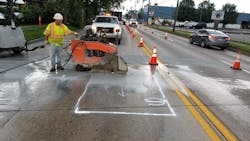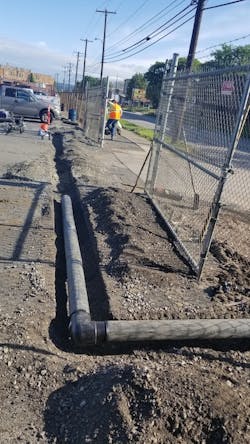About the author:
Edward Ellinger is assistant vice president for Herbert, Rowland & Grubic Inc. Ellinger can be reached at [email protected]. Jeffrey Bowra is lead engineer for Capital Region Water. Bowra can be reached at [email protected].
No utility wants to shut off service or advise its customers to boil water. No one wants to shut down traffic on busy streets or hear that area homeowners have flooded basements, but this is what can happen when a utility experiences two water main breaks in one week, as Capital Region Water (CRW) did one wintry weekend.
CRW knew it needed to fix the aging cast iron pipes in this area, but workers also knew it would be a significant challenge. The area in question was in the heart of Pennsylvania’s state capital. The road above these pipelines carried thousands of vehicles per day to Interstates 81 and 83, the community college, the Pennsylvania Farm Show Complex, and government buildings. It was a concrete route owned and maintained by the state, and pavement restoration costs would be high.
The water mains in Cameron Street were installed in the 1890s, and Capital Region Water needed a way to improve the structural integrity of the water mains while avoiding traffic disruption and minimizing costly pavement disturbance. CRW leaders thought cured-in place-pipe (CIPP) lining could be the answer.
CRW operators and engineers were familiar with cured-in-place-pipe lining for sewer rehabilitation. However, they had never used it for a water main because lining used for water mains is different than that used for sewers. Water main pipelines have to resist soil pressures around the exterior pipe, as sewer line does, but they also have to resist the internal pressure of flows pushing out.
Therefore, CIPP lining for water mains typically has fiberglass or a similar material inside to provide additional strength. It also requires different resin for the curing process, a resin that meets NSF 61 requirements and is safe for potable use. However, unlike open cut trenching, contractors installing CIPP lining do not have to dig up the entire roadway. They only need to open a few access pits. This would be a huge advantage at this location given that it is a concrete road surface as opposed to bituminous pavement.
This procedure would save CRW money on pavement restoration and make it easier to maintain traffic through the heart of the city. Contractors can do the work at night and cover the access pits with steel plates during the day, so cars can travel through the area at reduced speed.
CRW asked its engineer to investigate the use of CIPP lining for the water distribution main along Cameron Street, and the engineer’s experience provides several good lessons to other utilities about how to ensure a successful water main rehabilitation project.
Determine Pipe Condition
Before planning a pipeline rehabilitation, determine the condition of the existing pipe as accurately as possible. Begin by examining its history of leaks and repairs and, perhaps, also extract a sample of the pipe to study the number and spacing of pits. Alternatively, use remote field technology to examine the inside of the pipe for signs of corrosion, weaknesses or leaks.
Sampling is more expensive than reviewing maintenance records, and remote field investigations are more expensive than sampling. How much is invested in assessing the condition of pipes will depend, in part, on the quality of the available records and the importance of a particular pipeline in the system.
Utilities like CRW that have a proactive asset management program in place are at an advantage because it already has condition assessment data on file and detailed records of maintenance and repairs. Because of this, CRW did not need to invest in more expensive examinations for this project. With a detailed history of water main breaks in the area, CRW knew it needed a fully structural lining.
The American Water Works Association has four classifications for water main linings. Class I linings are non-structural and essentially serve as a protective coating. Classes II and III are semi-structural, but only Class IV is fully structural and independent of the host pipe. This is the lining CRW and its engineer felt was the best option for Cameron Street.
Determine Performance Goals
Utilities planning a water main rehabilitation project also need to determine the desired performance and life cycle of the new pipeline, specifically the hydraulic and operating pressure requirements. Once the hydraulic and operating pressure requirements of the pipe (and its structural condition) are known, the field of options for rehabilitation or replacement narrows.
Before making a final selection, however, consider the conditions of the project site.Certain options such as pipe bursting, horizontal directional drilling and micro-tunneling are impractical in certain soils. (For example, pipe bursting is inappropriate in dense soil like clay.) In the case of CRW, high traffic volumes and costly pavement restoration requirements at the site made methods with minimal earth disturbance a preference.
Weight the Pros & Cons
Compare the cost of each pipeline replacement or rehabilitation method under consideration. Look at direct costs like labor and materials as well as indirect costs associated with public disruption. Consider immediate design and construction costs but also consider long-term operations and maintenance costs. In some cases, a particular approach may cost more up-front, but will provide significant savings over the life cycle because of reduced maintenance needs.
After considering all of these factors, CRW and its engineer felt increasingly confident that CIPP lining was the best choice for rehabilitating the water main along Cameron Street. It initiated preliminary design of the new pipelines and dove deeper into the details.
Dig into the Details
Details are important because the task of ensuring smooth progress for construction and reconnecting begins in the earliest phases of planning and design. Know the system well.
For instance, it is important to determine the location of service connections, hydrants, and other structures one might encounter underground during construction (such as storm water pipes or other utilities). CRW’s pipelines were generally built on a straight alignment, but as contractors began digging access pits, they discovered sections where vertical bends were installed in the water main to avoid storm pipes installed by the state in the early 1900s. The angle of the fittings at those crossing was too severe to feed the lining through them. As a result, the contractor had to install more pits than originally planned, which increased pavement restoration costs.
Evaluate the Surrounding Service Connections
Utilities will also want to determine the location and size of all service connections in the area before the pipe is lined. Knowing this information helps the utility and its engineer determine the most cost-effective way to reconnect service after the project is complete. CRW asked its contractor to record the location of each service connection using CCTV equipment before lining the pipe. After the lining cured, a robot traveled inside the pipe and drilled a hole inside the liner at each location to reinstate service. Developing this plan in advance reduced the need to excavate pavement at each service connection, which saved the utility thousands of dollars.
Cost savings like this are a primary concern for any utility but so is customer satisfaction. Identify which customers will lose service while a portion of the system is shut down for construction, so alternative access to water can be provided. While one can count the parcels that have direct connection to the waterline being addressed, one should also look at mapping to see if that line feeds other branches in the system. If so, people outside the immediate construction zone will be affected, and alternative access will be necessary for them.
Mapping Efficiency With Existing Assets
Look at GIS mapping to identify where the existing system is looped. This may allow flow of supply water to some affected customers through other mains in the city if there is redundancy. If this is not an option for all affected customers, it may require designing a temporary water system, as CRW’s engineer did for this project. First, identify water demands in the area and work with the fire department to determine fire flow needs. Then create a model to properly size the temporary system.
Because of the need to minimize earth disturbance, portions of CRW’s temporary water system were built above ground; therefore, security was a critical concern. In cases like this, make sure someone is on-site at all times to prevent tampering with the system.
Engage All Stakeholders
Long before shovels hit earth, engage stakeholders in the community, to minimize any negative impacts and ensure everyone’s concerns are adequately addressed. This includes:
- The fire department to ensure it has adequate, uninterrupted water supply;
- Emergency responders to consider how lane closures and detours could impact emergency routes;
- Area businesses, who might lose customers to road closures or may need to schedule an inspection before bringing fire suppression systems back online;
- Utilities, who may have infrastructure in the ground where the contractor will be digging;
- Transportation agencies or roadway departments to determine pavement restoration requirements and advise on detours or lane closures;
- Local government officials, who will know if other construction projects are planned in the area and can advise of opportunities to schedule them to minimize disturbances;
- Contractors, who can provide valuable insight on constructability issues while designs are still being planned; and
- Customers, who deserve to know the timing and impact to their service.
That said, it is impossible to protect against all contingencies. There will always be a chance that unexpected issues arise during design and construction that can add cost or create delay, but a quality consultant will minimize that risk by conducting thorough investigations, communicating effectively with stakeholders, and planning proactively.
Communication does more than reduce risk, it also builds good will in the community. That is a value that cannot easily be measured but will pay dividends for years to come.
A report from Bluefield Research indicates that U.S. utilities lose 15% of their water each year to leaks, but deteriorating pipes can also cause health concerns or issues with color, clarity and taste. The rehabilitation of pipelines is the fastest growing capital expenditure for water and wastewater utilities and is expected to more than double by 2028, according to Bluefield’s report.
Knowing how to successfully replace or rehabilitate water lines, including how to select an appropriate method and how to reduce potential issues during construction and reconnection are important for utility managers to consider.


